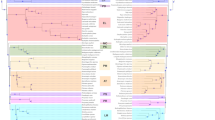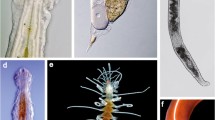Abstract
Euparyphium capitaneum Dietz, 1909, the type-species of the genus Euparyphium Dietz, 1909, is described on the basis of material collected from the type-host Anhinga anhinga (L.) from Pascagoula River, which drains into the northern coast of the Gulf of Mexico. Combination of light and scanning electron microscopy observations of freshly collected and properly fixed specimens in our study has allowed us to provide novel information on the morphology and topology of the reproductive systems and other morphological features of the species. A Bayesian inference analysis based on the newly-obtained partial sequence of the nuclear 28S rRNA gene for E. capitaneum and 24 previously published sequences from the superfamily Echinostomatoidea Looss, 1899 provided evidence supporting the distinct status of the genera Euparyphium and Isthmiophora Lühe, 1909.




Similar content being viewed by others
References
Bergmame, L., Hyffman, J., Cole, R., Dayanandan, S., Tkach, V., & McLaughlin, J. D. (2011). Sphaeridiotrema globulus and Sphaeridiotrema pseudoglobulus (Digenea): species differentiation based on mtDNA (Barcode) and partial LSU-rDNA sequences. Journal of Parasitology, 97, 1132–1136.
Church, M. L., Barrett, P. M., Swenson, J., Kinsella, J. M., & Tkach, V. V. (2013). Outbreak of Philophthalmus gralli in four greater rheas (Rhea americana). Veterinary Ophthalmology, 16, 65–72.
Dietz, E. (1909). Die Echinostomiden der Vögel. Zoologischer Anzeiger, 34, 180–192.
Dietz, E. (1910). Die Echinostomiden der Vögel. Zoologische Jahrbücher, 12, 256–512.
Esteban, J. G., Toledo, R., Sánchez, L., & Muñoz-Antolí, C. (1997). Life-cycle of Euparyphium albuferensis n. sp. (Trematoda: Echinostomatidae) from rats in Spain. Systematic Parasitology, 38, 211–219.
Georgieva, S., Kostadinova, A., & Skírnisson, K. (2012). The life-cycle of Petasiger islandicus Kostadinova & Skirnisson, 2007 (Digenea: Echinostomatidae) elucidated with the aid of molecular data. Systematic Parasitology, 82, 177–183.
Griffin, M. J., Khoo, L. H., Quiniou, S. M., O’Hear, M. M., Pote, L. M., Greenway, T. E., Wise, D. J. (2012). Genetic sequence data identifies the cercaria of Drepanocephalus spathans (Digenea: Echinostomatidae), a parasite of the double-crested cormorant (Phalacrocorax auritus), with notes on its pathology in juvenile channel catfish (Ictalurus punctatus). Journal of Parasitology, 98, 967–972.
Hall, T. A. (1999). BioEdit: a user-friendly biological sequence alignment editor v. 5.0.9. Nucleic Acids Symposium, 41, 95–98.
Heneberg, P. (2013). Phylogenetic data suggest the reclassification of Fasciola jacksoni (Digenea: Fasciolidae) as Fascioloides jacksoni comb. nov. Parasitology Research, 112, 1679–1689.
Huelsenbeck, J. P., & Ronquist, F. (2001). MrBayes: Bayesian inference of phylogeny. Bioinformatics, 17, 754–755.
Kanev, I., Radev, V., & Fried, B. (2002). Family Cyclocoelidae Stossich, 1902. In: Gibson, D. I., Jones, A. & Bray, R. A. (Eds) Keys to the Trematoda, Volume 1. Wallingford: CAB International, pp. 131–145.
Kostadinova, A. (2005). Family Echinostomatidae Looss, 1899. In: Jones, A., Bray, R. A. & D. I. Gibson, D. I. (Eds) Keys to the Trematoda, Volume 2. Wallingford: CAB International and The Natural History Museum, pp. 9–64.
Kostadinova, A., & Gibson, D. I. (2002). Isthmiophora Lühe, 1909 and Euparyphium Dietz, 1909 (Digenea: Echinostomatidae) re-defined, with comments on their nominal species. Systematic Parasitology, 52, 205–217.
Literák, I., Heneberg, P., Sitko, J., Wetzel, E. J., Cardenas Callirgos, J. M., Čapek, M., Valle Basto, D., & Papoušek, I. (2013). Eye trematode infection in small passerines in Peru caused by Philophthalmus lucipetus, an agent with a zoonotic potential spread by an invasive freshwater snail. Parasitology International, 62, 390–396.
Lotfy, W. M., Brant, S. V., DeJong, R. J., Le, T. H., Demiaszkiewicz, A., Rajapakse, R. P., Perera, V. B., Laursen, J. R., & Loker, E. S. (2008). Evolutionary origins, diversification, and biogeography of liver flukes (Digenea, Fasciolidae). American Journal of Tropical Medicine and Hygiene, 79, 248–255.
Mendheim, H. (1943). Beiträge zur Systematik und Biologie der Familie Echinostomatidae (Trematoda). Archiv für Naturgeschichte, 12, 175–302.
Nylander, J. A. A. (2004). MrModelTest 2.3. Program Distributed by the Author. Uppsala University; Uppsala, Switzerland.
Olson, P. D., Cribb, T. H., Tkach, V. V., Bray, R. A., & Littlewood, D. T. J. (2003). Phylogeny and classification of the Digenea (Platyhelminthes: Trematoda). International Journal for Parasitology, 33, 733–755.
Pérez Vigueras, I. (1944). Trematodes de la super-familia Echinostomatidae, con descripción de siete especies nuevas de Cuba. Revista de la Universidad de la Habana, 57, 221–234.
Premvati, G. (1968). Echinostome trematodes from Florida birds. Proceedings of the Helminthological Society of Washington, 35, 197–200.
Rambaut, A. (2012). FigTree v. 1.4. Molecular evolution, phylogenetics and epidemiology. Edinburgh, UK: University of Edinburgh, Institute of Evolutionary Biology, http://tree.bio.ed.ac.uk/software/figtree/.
Sato, H., & Suzuki, K. (2006). Gastrointestinal helminthes of feral raccoons (Procyon lotor) in Wakayama Prefecture, Japan. Journal of Veterinary Medical Science, 68, 311–318.
Skrjabin, K. I., & Bashkirova, E. Y. (1956). Family Echinostomatidae. Osnovy Trematodologii, 12, 53–930 (In Russian).
Tkach, V. V., Littlewood, D. T. J., Olson, P. D., Kinsella, J. M., & Świderski, Z. (2003). Molecular phylogenetic analysis of the Microphalloidea Ward, 1901. Systematic Parasitology, 56, 1–15.
Tkach, V. V., & Pawlowski, J. (1999). A new method of DNA extraction from the ethanol-fixed parasitic worms. Acta Parasitologica, 44, 147–148.
Tkach, V., Pawlowski, J., & Mariaux, J. (2000). Phylogenetic analysis of the suborder Plagiorchiata (Platyhelminthes, Digenea) based on partial lsrDNA sequences. International Journal for Parasitology, 30, 83–93.
Tkach, V., Pawlowski, J., Mariaux, J., & Swiderski, Z. (2001). Molecular phylogeny of the suborder Plagiorchiata and its position in the system of Digenea. In: Littlewood, D. T. J. & Bray, R. A. (Eds) Interrelationships of the Platyhelminthes. London: Taylor & Francis, pp. 186–193.
Tkach, V. V., Schroeder, J. A., Greiman, S. E., & Vaughan, J. A. (2012). New genetic lineages, host associations and circulation pathways of Neorickettsia endosymbionts of digeneans. Acta Parasitologica, 57, 285–292.
Yamaguti, S. (1958) Systema helminthum. Vol. 1. The digenetic trematodes of vertebrates. New York: Interscience Publishers, 1,575 pp.
Acknowledgements
The authors thank Dr. Robin Overstreet (Gulf Coast Research Laboratory, University of Southern Mississippi, Ocean Springs, USA) who generously provided laboratory facility and equipment for collecting and processing of birds. Donna Laturnus (Department of Anatomy and Cell Biology, School of Medicine and Health Sciences, University of North Dakota) kindly provided technical assistance with preparation of samples for scanning electron microscopy. Birds were collected under USFWS permit MB681207-0 and Mississippi “Administrative Scientific Collecting Permit” issued annually to Robin M. Overstreet by the Mississippi Museum of Natural Science. This study was supported in part by the National Sciences Foundation award DEB1050525 to VVT and the European Union Structural Funds project “Postdoctoral Fellowship Implementation in Lithuania” (VP1-3.1-ŠMM-01-V-02-004) to OK.
Author information
Authors and Affiliations
Corresponding author
Rights and permissions
About this article
Cite this article
Kudlai, O., Tkach, V.V., Pulis, E.E. et al. Redescription and phylogenetic relationships of Euparyphium capitaneum Dietz, 1909, the type-species of Euparyphium Dietz, 1909 (Digenea: Echinostomatidae). Syst Parasitol 90, 53–65 (2015). https://doi.org/10.1007/s11230-014-9533-0
Received:
Accepted:
Published:
Issue Date:
DOI: https://doi.org/10.1007/s11230-014-9533-0




